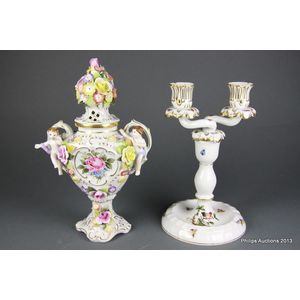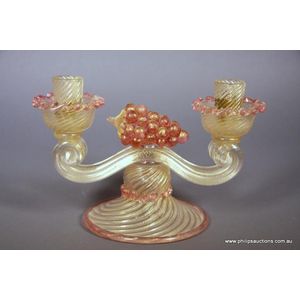Gold Dust Murano Glass Candlestick
You must be a subscriber, and be logged in to view price and dealer details.
Subscribe Now to view actual auction price for this item
When you subscribe, you have the option of setting the currency in which to display prices to $Au, $US, $NZ or Stg.
- Circa - A Latin term meaning 'about', often used in the antique trade to give an approximate date for the piece, usually considered to be five years on either side of the circa year. Thus, circa 1900 means the piece was made about 1900, probably between 1895 and 1905. The expression is sometimes abbreviated to c.1900.
- Inclusions - Inclusions in glass objects refer to small, often irregularly shaped particles or bubbles that are trapped within the glass during the manufacturing process. These inclusions can be intentional or unintentional, and can range in size, shape, and composition.
Intentional inclusions are often added to the glass for decorative purposes, and can include materials such as colored glass, metallic foils, or even small mementos like photographs or other objects. These intentional inclusions are typically added to the glass while it is still in a molten or semi-molten state and are then moulded or blown into the final shape of the object.
Unintentional inclusions, on the other hand, are typically the result of impurities or air bubbles that become trapped within the glass during the manufacturing process. These inclusions can be seen as small specks or bubbles within the glass, and can sometimes be a sign of poor quality control during production.
While intentional inclusions can be a desirable feature of some glass objects, unintentional inclusions can sometimes be seen as a defect, and can reduce the value of a piece. However, in some cases, certain types of unintentional inclusions can actually increase the value of a piece, such as with antique glass that contains bubbles or other imperfections that are characteristic of the time period in which it was made. - Decor Bois - "Decor bois" is a French term that translates to "wood decor" in English. It refers to decorative elements painted on porcelain items that simulate decorations in timber, such as carvings.
- Aventurine Glass - Aventurine glass is a type of glass where small flakes of gold, copper, or silver color form in the glass and provide a glitter or sparkle to the glass when seen in the light. The small flakes are created by adding copper, gold or silver to the molten glass during the glassmaking process.
This item has been included into following indexes:
Visually similar items

A German porcelain covered vase and a candelabrum, the vase Porzellan Manufaktur Plaue (Pmp), Thuringia, the candelabrum Herend, Hungary, the vase in the eighteenth century manner, decorated with painted and applied flowers and a pair of putti, the candela

A Belleek 'Prince Arthur' vase, 1891-1926, Second black mark period, of typical form with a trumpet neck and boat shaped body with scrolling integral handles upon a moulded pedestal foot, in a cream pearl finish with moulded decorations throughout and encr

Five marigold carnival glass items, to include 4 bowls & 1 vase 27 cm high approx.

Royal Worcester nautilus shell vase, height 18 cm
